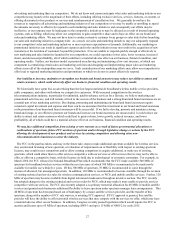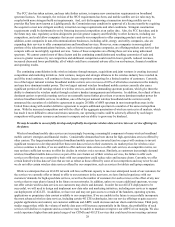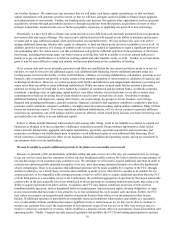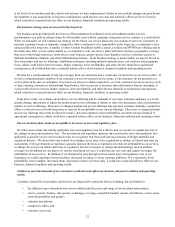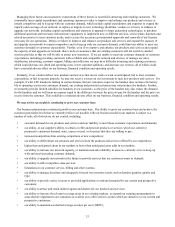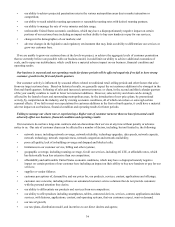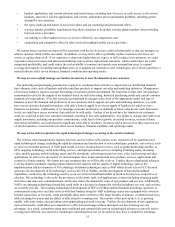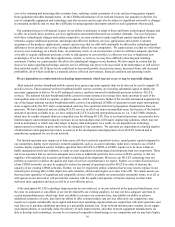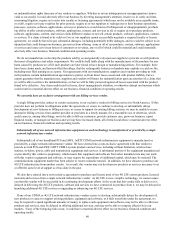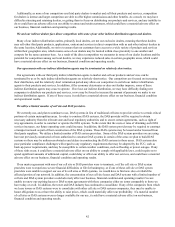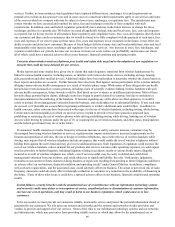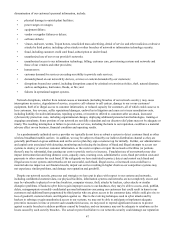Metro PCS 2011 Annual Report Download - page 48
Download and view the complete annual report
Please find page 48 of the 2011 Metro PCS annual report below. You can navigate through the pages in the report by either clicking on the pages listed below, or by using the keyword search tool below to find specific information within the annual report.37
costs or be required to change network infrastructure vendors, which would result in lost time and expense. Further, our 4G
LTE expansion may result in the degradation of our existing services. There can be no assurance that our 4G LTE services will
meet customer expectations, provide wireless broadband mobile data service on a profitable basis, that we will be able to enter
into roaming arrangements for 3G/4G services on economical terms or at all, or that vendors will develop and make available
to companies of our size popular applications and handsets with features, functionality and pricing desired by customers. These
risks could reduce our customer growth, increase our costs of providing services and increase our churn, which could have a
material adverse effect on our business, financial condition and operating results.
We also are planning to utilize Voice over Long Term Evolution, or VoLTE, technology to improve efficiency in the
integration of voice and data services over our LTE networks, but we are dependent upon equipment manufacturers to develop
and deploy this advanced voice technology on a timely cost-effective basis.
The success of our business is dependent on the development of products compatible with the services deployed by us.
We do not develop or manufacture any products and are dependent on the development of products, content, applications and
services by third parties for the services and technology we have deployed and provide on our spectrum. Two of our national
wireless broadband mobile competitors acquired a significant portion of the 700 MHz spectrum auctioned by the FCC. We
hold a 700 MHz license which is in a different spectrum block than the 700 MHz licenses being developed by the two largest
national wireless broadband mobile competitors, which presents certain risks because some equipment manufacturers are
focusing their 700 MHz equipment development efforts on the channel blocks held by and/or being developed by the major
carriers, and the 700 MHz equipment made by these manufacturers may not be cross-compatible for use on the 700 MHz
channel block we hold. As a result, we may be unable to use, or may be materially delayed in using, our 700 MHz spectrum.
And, we may have higher costs for devices and equipment for our 700 MHz spectrum and the prospects for both inbound and
outbound roaming may be limited on 700 MHz spectrum. Further, we are deploying 4G LTE on PCS and AWS spectrum so
unless our customer's handsets are capable of using the 700 MHz spectrum on which our competitors are deploying 4G LTE,
our customers will not be able to roam on our competitors' networks for 4G LTE services assuming we are successful in
obtaining roaming arrangements with such competitors.
We have elected to deploy 4G LTE on our AWS and PCS spectrum. Several of our competitors have publicly indicated that
they plan to deploy, and at least one has deployed, 4G LTE on 700 MHz spectrum. There can be no assurance that other
licensees, including the national wireless broadband mobile carriers, will not delay or ultimately not deploy 4G LTE on AWS
and PCS spectrum. If other wireless broadband mobile licensees, including the large national wireless broadband mobile
carriers, do not deploy 4G LTE on AWS and PCS, we may have to pay higher prices for the products that we sell to our
customers due to the limited number of users, we may not have products available to us at all, or such products may be limited
in nature and not have the features and functions our customers expect or demand, and our customers may have limited
roaming. In addition, such limitation could result in less technological development on network equipment that we use to offer
4G LTE services, delays in any available technological developments and we could be forced to pay higher prices for any such
technological development. In addition, we are dependent on the national wireless broadband carriers continuing to deploy
handsets and handset operating systems to which we have access. If the national wireless broadband carriers choose to deploy
proprietary handsets or proprietary handset operating systems in lieu of, or substantially in lieu of, handsets and handset
operating systems to which we have access, we could experience higher prices for handsets and development of applications
for the handsets and handset operating systems we deploy may lag the development on other handsets and handset operating
systems. Further any handsets and handset operating systems that we deploy may lag behind the development of other handsets
and handset operating systems with which we compete, or may not be developed at all. If we are unable to secure the
necessary products at prices which will allow us to be competitive with other carriers of 4G LTE services, we may not be able
to meet our customer expectations, demands, or needs, which could have a material adverse effect on our business, financial
condition, or operating results.
We may be unable to provide 4G LTE roaming.
We do not anticipate being able initially, and may not in the future be able, to provide 4G LTE roaming service to our
customers to allow them to have 4G LTE service outside our existing service areas. Since at this time a limited number of
carriers have publicly announced that they are planning to deploy 4G LTE in the near future, the number of potential roaming
partners for 4G LTE will be extremely limited and certain carriers are currently deploying, and other carriers may deploy, 4G
LTE on spectrum that is different than the spectrum on which we are deploying 4G LTE. Other carriers have in the past, and
may in the future, be reluctant to provide data roaming to us at all or on terms we consider to be acceptable. In addition, some
of the carriers who currently provide roaming to us may be delayed in deploying, decide not to deploy, or be unable to deploy
4G LTE, which would limit our ability to provide 4G LTE services to our customers when they roam. Further, since 4G LTE is
relatively new and carriers may attempt to differentiate their services using 4G LTE, carriers may be reluctant to allow roaming


